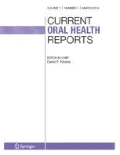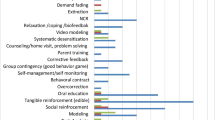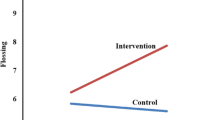Abstract
Dental caries is the most common chronic disease in children and is caused by poor oral health behaviors. These behaviors include high-sugar diet, inadequate exposure to topical fluorides, and irregular use of professional dental care services. A number of behavioral intervention approaches have been used to modify health behaviors. One example is based on the Screening, Brief Intervention, and Referral to Treatment (SBIRT) model, which has been widely used to reduce substance abuse in both adults and children. SBIRT is a promising behavior change approach that could similarly be used to address problematic oral health behaviors. In this paper, we will review oral health studies that have adopted SBIRT components, assess if these interventions improved oral health behaviors and outcomes, and outline considerations for researchers interested in developing and testing future oral health-related interventions in dentistry using a SBIRT approach.
Similar content being viewed by others
References
Papers of particular interest, published recently, have been highlighted as: • Of importance •• Of major importance
U.S. Department of Health and Human Services (USDHHS). Oral health in America: a report of the surgeon general—executive summary. Rockville: USDHHS, NIDCR, NIH; 2000.
Dye BA et al. Dental caries and sealant prevalence in children and adolescents in the United States, 2011–2012. NCHS Data Brief. 2015;191:1–8.
Dye BA, Li X, Thornton-Evans G. Oral health disparities as determined by selected Healthy People 2020 oral health objectives for the United States, 2009–2010. NCHS Data Brief. 2012;104:1–8.
Chi DL, Rossitch KC, Beeles EM. Developmental delays and dental caries in low-income preschoolers in the USA: a pilot cross-sectional study and preliminary explanatory model. BMC Oral Health. 2013;13:53.
Treadwell HM, Northridge ME. Oral health is the measure of a just society. J Health Care Poor Underserved. 2007;18(1):12–20.
Riddle M, Clark D. Behavioral and social intervention research at the National Institute of Dental and Craniofacial Research (NIDCR). J Public Health Dent. 2011;71(1):123–9.
McCance-Katz EF, Satterfield J. SBIRT: a key to integrate prevention and treatment of substance abuse in primary care. Am J Addict. 2012;21(2):176–7.
Moyer VA, U.S. Preventive Services Task Force (USPSTF). Screening and behavioral counseling interventions in primary care to reduce alcohol misuse: U.S. Preventive Services Task Force recommendation statement. Ann Intern Med. 2013;159(3):210–8.
Yuma-Guerrero PJ et al. Screening, brief intervention, and referral for alcohol use in adolescents: a systematic review. Pediatrics. 2012;130(1):115–22.
Moyer VA, U.S. Preventive Services Task Force (USPSTF). Primary care behavioral interventions to reduce illicit drug and nonmedical pharmaceutical use in children and adolescents: U.S. Preventive Services Task Force recommendation statement. Ann Intern Med. 2014;160(9):634–9.
Mitchell SG et al. SBIRT for adolescent drug and alcohol use: current status and future directions. J Subst Abuse Treat. 2013;44(5):463–72.
Johnston BD et al. Behavior change counseling in the emergency department to reduce injury risk: a randomized, controlled trial. Pediatrics. 2002;110:267–74.
Harris SK, Louis-Jacques J, Knight JR. Screening and brief intervention for alcohol and other abuse. Adolesc Med State Art Rev. 2014;25(1):126–56.
Levy SJ et al. Substance use screening, brief intervention, and referral to treatment for pediatricians. Pediatrics. 2011;128(5):e1330–40.
Ghitza UE, Tai B. Challenges and opportunities for integrating preventive substance-use-care services in primary care through the Affordable Care Act. J Health Care Poor Underserved. 2014;25(1):36–45.
Binkley CJ, Garrett B, Johnson KW. Increasing dental care utilization by Medicaid-eligible children: a dental care coordinator intervention. J Public Health Dent. 2010;70:76–84. This is one of the first published studies describing a dental intervention based on the SBIRT model.
Källestål C. The effect of five years’ implementation of caries-preventive methods in Swedish high-risk adolescents. Caries Res. 2005;39:20–6.
Weinstein P, Harrison R, Benton T. Motivating mothers to prevent caries: confirming the beneficial effect of counseling. J Am Dent Assoc. 2006;137:789–93. This is one of the first dental behavioral interventions to test the concept of motivational interviewing as a way to improve dental behaviors and reduce dental disease.
Ismail A et al. Evaluation of a brief tailored motivational intervention to prevent early childhood caries. Community Dent Oral Epidemiol. 2011;39:433–48.
Harrison R, Veronneau J, Leroux B. Effectiveness of maternal counseling in reducing caries in Cree children. J Dent Res. 2012;91:1032–7.
Riedy CA et al. Dental attendance among low-income women and their children following a brief motivational counseling intervention: a community randomized trial. Soc Sci Med. 2015;144:9–18.
Brickhouse TH, Haldiman RR, Evani B. The impact of a home visiting program on children’s utilization of dental services. Pediatrics. 2013;132(2):S147–52.
Niederman R et al. A model for extending the reach of the traditional dental practice: the ForsythKids program. J Am Dent Assoc. 2008;139:1040–50.
Shirazi M et al. Targeting and tailoring health communications in breast screening interventions. Prog Community Health Partnersh. 2015;9:83–9.
Jarrett C et al. Strategies for addressing vaccine hesitancy—a systematic review. Vaccine. 2015;33(34):4180–90. This systematic review calls for tailored behavioral interventions to address problem health behaviors like vaccine hesitancy.
Chi DL. Caregivers who refuse preventive care for their children: the relationship between immunization and topical fluoride refusal. Am J Public Health. 2014;104(7):1327–33.
Bartholomew LK, Mullen PD. Five roles for using theory and evidence in the design and testing of behavior change interventions. J Public Health Dent. 2011;71(1):S20–33. This publication describes the role and importance of theory in developing and testing behavior change interventions.
Mars T et al. Fidelity in complex behaviour change interventions: a standardised approach to evaluate intervention integrity. BMJ Open. 2013;3(11), e003555.
Reho K et al. Are we there yet? A review of screening, brief intervention, and referral to treatment (SBIRT) implementation fidelity tools and proficiency checklists. J Prim Prev. 2016:1–12.
Chi DL et al. Relationship between medical well baby visits and first dental examinations for young children in Medicaid. Am J Public Health. 2013;103(2):347–54.
Agerwala SM, McCance-Katz EF. Integrating screening, brief intervention, and referral to treatment (SBIRT) into clinical practice settings: a brief review. J Psychoactive Drugs. 2012;44(4):307–17.
Author information
Authors and Affiliations
Corresponding author
Ethics declarations
Conflict of Interest
Josué Cuevas and Donald L. Chi declare that they have no conflict of interest.
Human and Animal Rights and Informed Consent
This article does not contain any studies with human or animal subjects performed by any of the authors.
Additional information
This article is part of the Topical Collection on Dental Public Health
Rights and permissions
About this article
Cite this article
Cuevas, J., Chi, D.L. SBIRT-Based Interventions to Improve Pediatric Oral Health Behaviors and Outcomes: Considerations for Future Behavioral SBIRT Interventions in Dentistry. Curr Oral Health Rep 3, 187–192 (2016). https://doi.org/10.1007/s40496-016-0106-y
Published:
Issue Date:
DOI: https://doi.org/10.1007/s40496-016-0106-y




